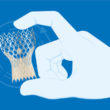Transcatheter aortic valve replacement (TAVR) has shown remarkable benefits and continues to advance towards lower-risk patients and younger ages. However, one of its limitations lies in the demand for a permanent pacemaker (PPM), which during TAVR early stages with self-expanding valves reached 30%. Uncertainty persists regarding the evolution of patients undergoing PPM implantation after TAVR,...
SOLACI-SBHCI 2023 | TAVR – Lifetime Management of Patients with Aortic Stenosis – Dr. Ole de Backer
Read the most outstanding articles from SOLACI-SBHCI 2023 Congress. In this case, check the presentation by Dr. Ole de Backer, entitled “TAVR – Lifetime Management of Patients with Aortic Stenosis”
TAVR Durability at 5 Years in Intermediate Risk Patients
TAVR has been shown beneficial in patients across the risk spectrum. The PARTNER 2 SAPIEN 3 (P2S3i) study on intermediate risk patients was the first to show TAVR superiority vs SAVR when using the transfemoral approach. SAVR durability has been shown in different analysis but, except for a few reports, TAVR durability at long term...
Aortic Stenosis and Cardiogenic Shock: Is TAVR an Option?
Cardiogenic shock (CS) in a setting of aortic stenosis is associated with high mortality rates. In consequence, surgery is generally not a possibility for this patient group, and they usually undergo aortic valvuloplasty, resulting in a mortality rate of 33%-50% at 30 days, 70% at one year, and 90% at two years. While transcatheter aortic...
VASC-OBSERVANT II Substudy: Impact of Vascular Complications after TAVR
At present, transcatheter aortic valve replacement (TAVR) has become increasingly common to treat severe symptomatic aortic stenosis, with the transfemoral approach being the most common access strategy, associated to better outcomes vs. other access sites. Even though vascular complication rates (VC) have dropped given increased operation experience and improved devices, such as the use of...
TAVR: Does HALT Affect Follow-Up?
Transcatheter aortic valve replacement (TAVR) in low-risk patients has been shown to be superior or noninferior in randomized studies, but the presence of valvular thrombosis, in its different forms, has not been well analyzed, nor is there much information on its impact on evolution. Researchers conducted an analysis of the LTR study that included 200...
Impact of Right Ventricular Pacing in Patients with Permanent Pacemaker Implantation after TAVR
Permanent pacemaker implantation (PPI) is a relevant complication in patients undergoing transcatheter aortic valve replacement (TAVR) despite there being new devices. The current information on the long term impact of this complication remains unclear and recent evidence suggests post-TAVR ventricular pacing (VP) might be associated to higher risk of all-cause mortality and hospitalization for cardiac...
EuroPCR 2023 | TAVR in TAVR Results with Balloon-Expandable Valves
With the expansion of transcatheter aortic valve replacement (TAVR) use in the low-risk population, more patients will need repeat valve replacement in the future, making it paramount to understand the performance of repeat TAVR. Currently, this information is limited. The aim of this study was to analyze the real-world experience of performing a second TAVR...
EuroPCR 2023 | TAVR in Patients with Bicuspid Aortic Valve Stenosis
Bicuspid aortic valve (BAV) stenosis is the most common congenital valve disease, affecting up to 2% of the population. Patients with BAV disease undergoing transcatheter aortic valve replacement (TAVR) account for 0.5%. In this context, TAVR data on BAV stenosis patients has been limited to observational studies on first generation valves that had resulted in...
EuroPCR 2023 |Chimney Stenting vs BASILICA for the Prevention of Coronary Obstruction during TAVR
Coronary obstruction is a complication from TAVR that can cause death (up to 50% mortality), even though its incidence is lower than 1%. One of the most frequent strategies used in the prevention of this complication is chimney stenting in patients at high anatomical risk (valve in valve, narrow sinotubular junction, short coronary ostium height)....







